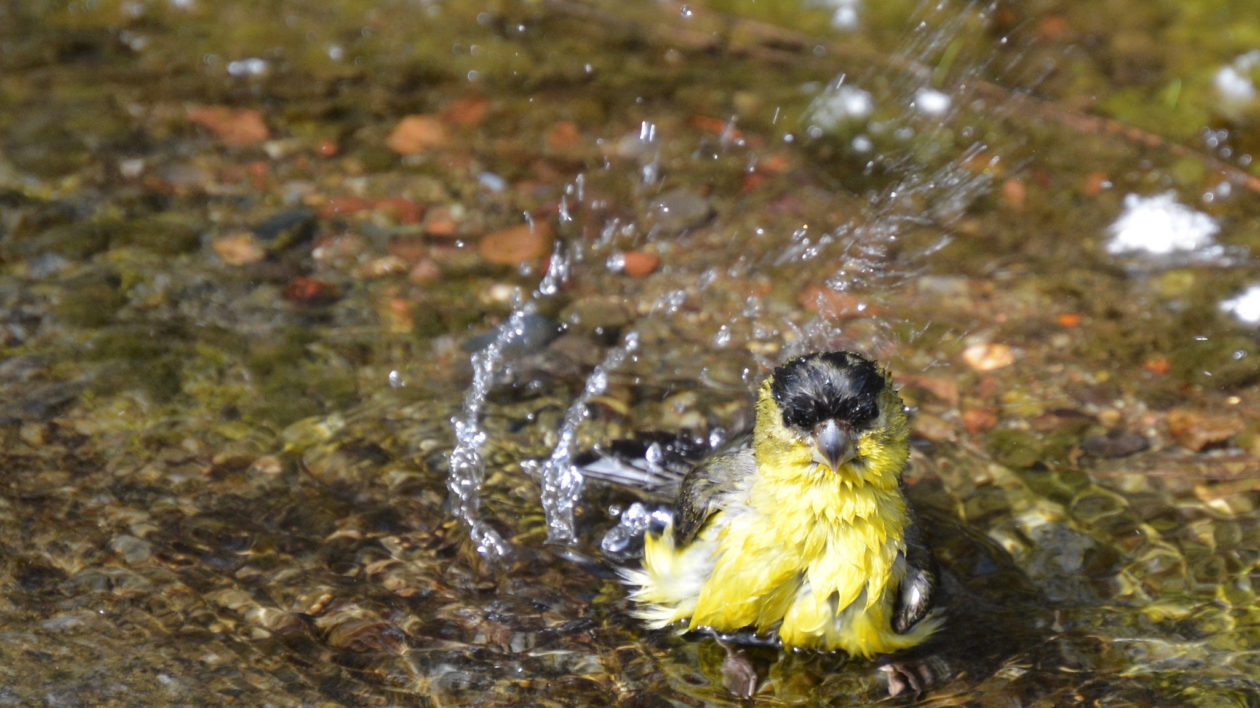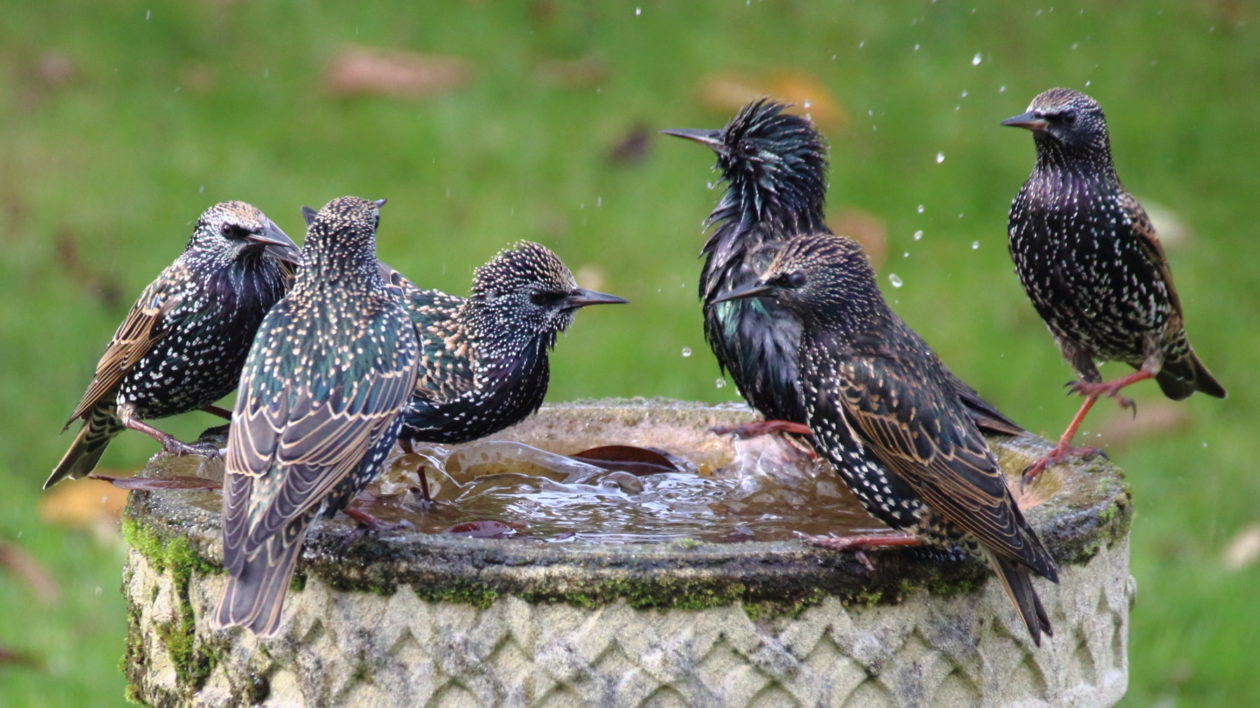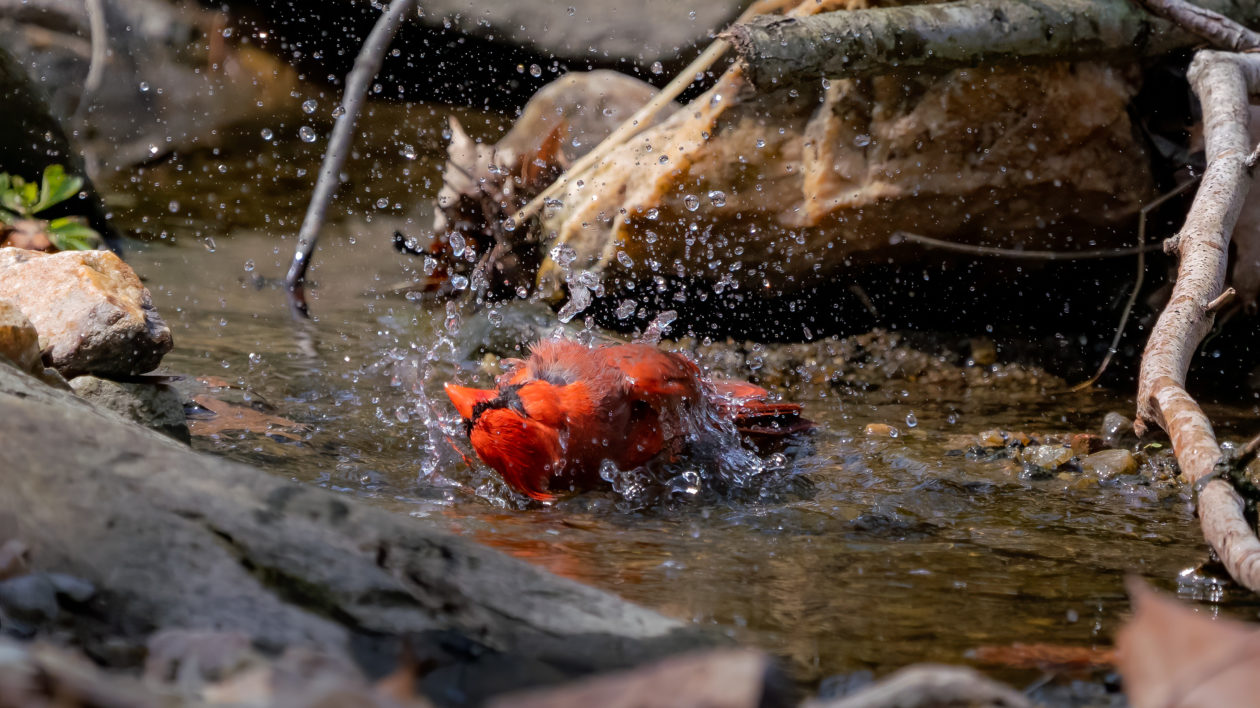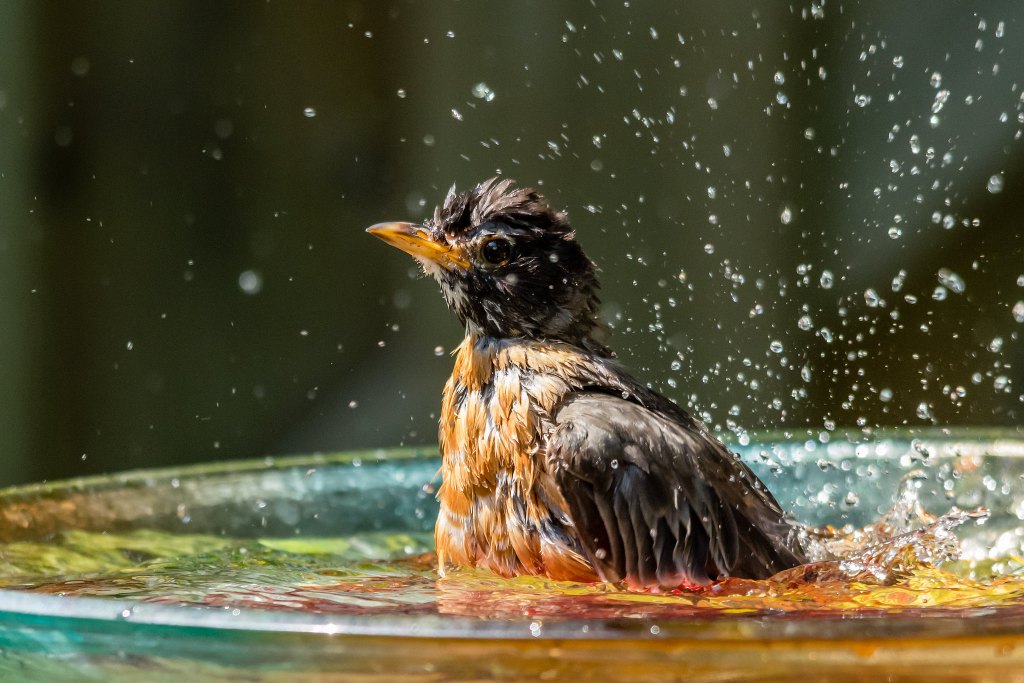What does science tell us about the importance of a good bath to a bird?
The answer: surprisingly little!
A study published in 2009 stated it plainly: “Birds of most species regularly bathe in water, but the function of this behavior is unknown” 1.
This post is about the cool green science of bird baths: what we know and intriguing areas of inquiry for future research.
Rub-a-Dub-Dub, Many Birds in the Tub
Despite the lack of knowledge about the function and importance of baths to birds, we all know that birds (like the rest of us) love having water around for bathing and drinking.
When working with migrant birds in the Yucatan Peninsula, I first began to understand how seriously birds take the business of bathing. We were studying warblers that were typically territorial. These birds frequently engaged in threat postures and even in fights to enforce the boundaries between their exclusive home ranges at our mangrove study sites.
But at a communal bird bath, there was a nightly truce.

Each evening at dusk, in a special spot in the mangroves where a freshwater spring bubbled up from the ground, numerous American redstarts, northern parulas, magnolia warblers, common yellowthroats and yellow warblers took turns bathing.
One by one, they shared this little oasis before going to roost for the night.
Seeing territorial warblers calmly taking turns for a bath tells us that for a bird, having access to water for bathing is worth checking one’s combative tendencies—at least for a few minutes.

Why Birds Take Baths
So, what’s so important about a bath?
The number of relevant scientific articles can be counted on one hand. There are very basic descriptions of the mechanics of bird bathing in North American2 and Australian birds3, an experimental examination of wetting and drying of disembodied feathers4, and a recent pair of studies that experimentally deprived captive starlings of bath water 5,1.
Although the functions of bird bathing aren’t clearly known at this point, these studies suggest that bathing plays an important role in feather maintenance.
Feathers are a bird’s lifeline: they insulate, waterproof and, of course, provide the power of flight.
Feathers get replaced once or twice a year. In the interim, they need to be kept in good condition. The sun, feather-munching mites, bacteria and gradual wear take a toll on feathers. A set of year-old flight feathers look like they’ve been through the ringer: they are frayed and dull.

A good bath may keep those precious feathers in the best condition possible for as long as possible.
Two recent studies on captive starlings have progressed our understanding a bit further. In one paper, Brilot and colleagues hypothesized that depriving a bird of a bath would result in more disheveled feathers and translate into poorer flight performance.
They tested a group of freshly-bathed starlings and a group that had been deprived of a bath for three hours prior to the experiment. The starlings deprived of a bath were clumsier when flying through an obstacle course made of vertically-hung strings, bumping into more strings as they flew.
In their second paper on starlings, the research team examined whether the bath-deprived starlings knew they were clumsier. They did this by presenting bathed and unbathed groups of birds with recordings of starling predator alarm calls – and delicious meal worms – at the same time.
The experiment indicated that birds with access to bath water were more willing to let their guard down and feed, despite the recorded call signaling the presence of a predator. The authors suggest that the unbathed birds were more cautious because they were aware that their ability to escape was impaired.
This work tells us that, beyond preserving feathers over the long term, bathing even makes a bird a more agile flier and more adept at escaping predators in the short term.
These studies are helpful, but the function of bathing still eludes us.
How does it make these birds better fliers? Does it help realign the tiny barbs that hold feathers together? Does it help distribute protective oils? Does it improve feather performance in some other way?
This all leaves me wondering about those birds in the Yucatan. Our research was focused on revealing differences in habitat quality among individuals, mainly by measuring the food resources of the birds. We reasoned that more food equaled birds in better condition with a better chance of survival.
But maybe we were ignoring another important aspect of habitat quality – access to bathing water. We see from the starling work that being deprived of a bath could make an unbathed bird easier to catch, so baths might play a role in survival too.
Until we get an answer from science, we will need to rely on common sense and keep those backyard bird baths full.

Preparing Your Backyard Bird Bath
Many of us with bird feeders also have a bird bath to go along with it. Even in the coldest months of the year, I’ve found that birds are eager to take baths.
I recently poured a warm tea kettle of water into my frozen bird bath and there was an instant scrum as the cardinals and white-throated sparrows jockeyed for position around the bath.
A more sophisticated approach to maintaining a bird bath in winter is to use a bird bath heater.
When warmer times come around, a water mister can enhance the backyard bird bathing experience.
Misters keep water fresh and brings a lot more attention to the bird bath. They are a great bird attractor during the spring and summer when people typically aren’t feeding birds.
Although it would be nice to know the exact functions of bird bathing, a lack of scientific knowledge won’t ever get in the way of a good bath.




Thank you for your information. I have 4 different bird feeders out :regular seed mix, woodpecker blocks, finch block, and a block with mealy worms ( boy is that a favorite). Also, over the years I have 2 bird baths out. I have noticed that the robins, especially prefer to use one for bathing in. So, I change the water 3 times a day for them. Those little fellows sure get dirty. This gives me fun while I am in the kitchen ( French doors). So far over the years, I have found that we have at least 40-45 different species here in rural Indiana. I keep my National Audubon Society Field Guide to Birds ( Eastern region) to check out when a bird I don’t recognize shows up. Over the years, I have noticed that the Chipping Sparrows and Nuthatches do recognize me and will peck at the doors if the big wild seed feeder gets low. It has gotten to the point where they no longer are afraid of me, especially those two species and I can sit about 5 feet from the feeders. In the meantime, take care and stay safe during this time in our history. We came here as refugees after WWII, 1953. So obviously I am a senior citizen with time on my hands , as they say . Thanks again for your site.
Here is something that might add to the discussion of birds bathing. We are here in south-west Florida, and have a number of feeders and one pedestal bird bath. Unfortunately, the Common Grackles are constant visitors. Until the past week they’ve had little interest in the bath except the occasional drink. For the past week we’ve had flocks of American Robins coming to our yard and the love drinking and bathing in the bird bath. Well, when the Robins arrive each mid-afternoon, the Grackles are quick to hog the bird bath, and suddenly each and every Grackle takes a long bath, while the Robins sit and wait on the ground around the bird bath. Occasionally, the Robins will get their turn, but the Grackles are relentless. When the Robins aren’t there, not one Grackle takes a bath! We would love to know what this is all about.
I have often observed double barred finches, honeyeaters and wrens in Australia will come down for a bath and drink approximately every 2 hours. If the days are very hot (35C) the birds will come more often with the finches and wrens just sit in the water and interact socially. This may last for 4-5 minutes before the group start to move into the surrounding shrubbery to preen their feathers.
The bird baths consist of two 400mm glazed terracotta pot saucers, one green and one brown and third light brown plastic saucer. The finches prefer the green saucer and secondly the brown one. The wrens prefer the brown saucer and the honeyeaters the plastic one.
It appears the colour is important to each of the 3 species and it is common to see 10 or 20 finches, 3 male wrens and there 6 females all in at the same time.
What wonderful and important information!
What can I use to remove the bird oil off my window glass? Bird bath close to same and they splash a lot.
Wonderful! Thank you, Celeste W. Menlo Park, CA
I have a place in my yard for birds to eat and bathe, they just love it.
Many times the same bird takes three baths in a row. It is amazing how much they seem to love their baths.
We were puzzled to see small birds bathing in a plastic tray in our UK garden, even though its very cold and there is snow on the ground. Now we understand better why birds need water and that it’s not just for drinking, so we’ll take care that they always have a supply this winter/
Looking for a small bubbler for our birdbath. Is there such a thing?
Hi Janet, Thank you for the question! I can’t recommend anything specific, but I suggest searching with terms like “bird bath fountain pump.”
The first time I let my lovebird out of his cage he went right to my aquarium and jumped in! I was worried, but he got right out on his own and now bathes in there regularly!
Sir,my master asking me one question,is that,.
Which bird takes bath after eating meat ?
Will u Pls let me know.
Nice article! If we are to keep our birdbaths full, we need to fill (two baths) approximately every 2-3 hours in the summer. I live in Metro Detroit. We have limited the birds to having only 3 refills of water each day! There are usually 3-12 birds in each bath at any given moment. Mourning Doves are the last of the day, the circle the baths and face out towards the yard and stay until dusk. I keep a birdbath with a heater in the winter also.
Local murray magpies (small) regularly come to our ceramic bird bath, fluttering around and raising wings, and today in Spring a dove actually sat in the middle of same. More a small bird thing.
Adelaide Australia. Note the bird bath is in a small protected courtyard garden. But they do sense when I watch and clear off.
How about, the just enjoy a good bath!
Brids bathe to clean wings for the same reason planes are de-iced in winter, to remove drag on the wings?
It’s also possible that dirt buildup on planes also affect air flow for bulliency.